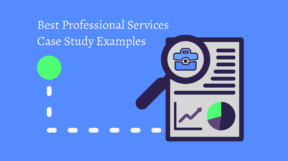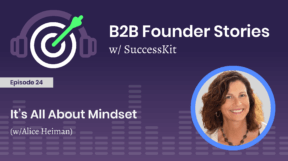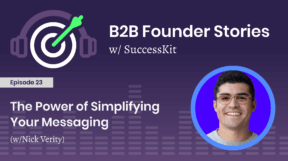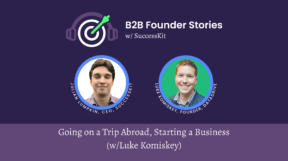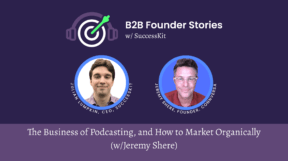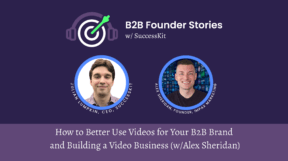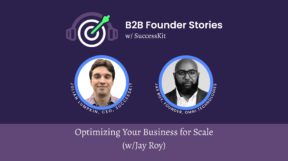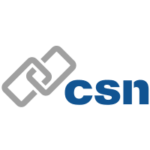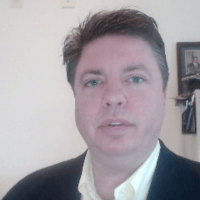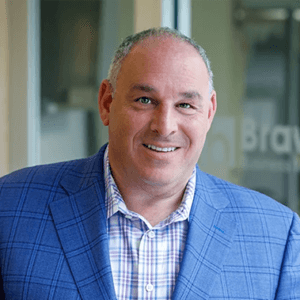Listen to this episode now on Spotify or Apple!
Shiv Narayanan, the founder and CEO of How to SaaS, stops by our B2B Founder Stories podcast to describe how he built the fully self-funded company in 2019 (and it’s now at about $3.5 million in revenue). He also identifies what mistakes he sees B2B SaaS marketers making, explains why hiring more salespeople isn’t always necessary to boost sales, and points out what trends are working now.
“Companies can have very aggressive growth targets and sales projections, but the bulk of that responsibility is put on the sales team, which makes sense to some degree, but it’s almost an incomplete thought. People heavily lean toward sales, but they don’t completely understand the role marketing has to play in that picture. And so the opportunity there is to right-size the marketing budget and actually uncover the right opportunities that marketing should be focused on to actually drive more pipeline. A good way I like to tell people about it is that if you have a sales problem today, there was likely a marketing problem about it six months ago, or twelve months ago, that it was unresolved and it’s now showing up in the numbers.”
Shiv Narayanan, Founder and CEO of How to SaaS
Transcript of Podcast Episode 15: Marketing Opportunities, Trends, and Missteps (w/Shiv Narayanan, Founder and CEO of How to SaaS)
Julian Lumpkin: Welcome back to B2B Founder Stories w/ SuccessKit. My guest today is Shiv Narayanan. He is the founder and CEO of How To SaaS. This was a really interesting conversation because we talk about his story of founding the company, which has grown really quickly based on his previous expertise, as well as general marketing trends that are relevant to a lot of companies today. I hope you enjoy the conversation. Shiv, thanks for joining.
Shiv Narayanan: Thanks for having me, Julian. Good to be here.
Julian Lumpkin: So, to kick us off, can you give us a quick blurb about How to SaaS, who you are and what you guys do?
Shiv Narayanan: Yeah, sure. So we are a management consulting firm and we work primarily with private equity investors and SaaS CEOs to help them build a scientific approach around marketing and demand generation. Best way to think about us as we productize what a CMO would do and we’ve condensed it into a three- to four-month engagement service. And we offer that almost as a strategy engagement. So think of it as like a McKinsey for marketing.
Julian Lumpkin: Got it. I want to get into kind of how you started the company, but let’s start with where you are now. Can you give us a sense of the size of your company in terms of headcount general idea of your revenue?
Shiv Narayanan: Yeah, so we’re twelve people. We founded the business in 2019. We’re at about 3.5 million in revenue as of last year and about 50 percent EBITDA margins.
Julian Lumpkin: Wow. Did you raise any financing?
Shiv Narayanan: No, fully self-funded and bootstrapped.
Julian Lumpkin: Very nice. So let’s go back to 2019. What were you doing before you started the company?
Shiv Narayanan: Yeah, so previously I was the CMO of a software company called WildApricot. Built that to about 20 million in ARR. And we did that without a sales team. And then in 2017, we got acquired by private equity. And then the PE bought us, flipped us to a different private equity firm in 2018. So through those two acquisitions, both of the PE investors that bought the businesses started pulling me into their other portfolio investments to help them on the marketing side. And so I saw that as an opportunity and instead of doing that internally for free, I thought it would be good to create an external partner to work with those investors to help them on the marketing side.
Julian Lumpkin: So you had some big successes. You probably could have gotten a job, a nice safe job working for one of those PE firms and their portfolio companies. What made you decide to start your own business?
Shiv Narayanan: Yeah, for me that was always the next logical step. Having been in the seat of leading the business on the marketing and growth side overall, and then also the way in which we had built WildApricot was quite unique. And that’s one of the things I learned is B2B software companies in general are sales lead, and marketing is one of the untapped levers inside those businesses. And there were a ton of frameworks and playbooks and best practices that I had developed in my time as a CMO. And this was also early days of SaaS. I started building the WildApricot business in 2014, and back then, not many people knew what SaaS was. And now kind of, everybody knows it about eight years later. So when we had been acquired, I just saw that as a huge opportunity and also a mission to actually help those businesses. Because that is an area where they need a ton of help. And I’ve seen a lot of marketers struggle. The tenure for VPC of Marketing is quite low. It’s like 18 months. A lot of VP of Marketing will start jobs and then get fired, or founders will raise money and not do well. So I just saw it as an opportunity to create some value in the marketplace as well. And I’m pretty passionate about that. Pieces.
Julian Lumpkin: Yeah. So digging into that a little bit before we go back to your business, what are some of the big mistakes you see B2B SaaS marketers making now in general?
Shiv Narayanan: We see companies—Well, number one, their budget allocation for marketing is usually quite low. They can have very aggressive growth targets and sales projections, but the bulk of that responsibility is put on the sales team. Which makes sense to some degree, but it’s almost an incomplete thought. So if you look at it as like a waterfall approach, it’s like, we want to hit aggressive growth projections. Well in order to do that well, we need to sell more deals. In order to sell more deals, we need more pipeline. Well, how do we generate more pipeline? And people heavily lean towards sales, but they don’t completely understand the role marketing has to play in that picture. And so the opportunity there is to right-size the marketing budget and actually uncover the right opportunities that marketing should be focused on to actually drive more pipeline. A good way I like to tell people about it is that if you have a sales problem today, there was likely a marketing problem about it six months ago, or twelve months ago, that it was unresolved and it’s now showing up in the numbers. And then the second part of it is that even if you have the right size budget, you have to focus on the right thing. So we come across tons of clients that may have a decent size budget, but they’re completely misallocating that budget to the wrong channels, the wrong programs, the wrong initiatives, when they don’t have the fundamentals in place, or don’t have the basic pieces of having a solid marketing engine built out. And so it’s really about educating them about what is the right order of doing things. Like, for example, you guys do Case Studies? Well, if you don’t have good Case Studies, well, what good is it? If you have a top-of-funnel blog post, you’re better off having a sales tool to actually convert people before you write random blog posts.
Julian Lumpkin: Certainly. I certainly always appreciate the plug for Case Studies. But it’s interesting going back to what you said before because I came from the sales side of this, and that’s why I kind of got into the Case Study business. But another thing that I saw when I worked at B2B SaaS startups, VC-backed ones. And I think this idea has become more known in common now, but there was a tendency, it was like, well, if we’re not getting enough opportunities, let’s hire more salespeople. And putting SDRs or even account executives in really tough positions to generate a lot of their own pipeline instead of kind of thinking about it as we’ll hire sales reps when the opportunities are actually available, and especially where you’re paying account executives, multi six figures. To have them not fully booked with meetings is not usually a good use of funds, in my opinion. Would you agree with the way I described it?
Shiv Narayanan: Totally. And I think the underlying reason why this exists is that there’s a fundamental misunderstanding about how revenue is actually generated. So I think the math almost at a board level or an executive committee level, is not being done. So if you, let’s say, you need to hit aggressive growth projections, one of the things we talk about, some of these topics are also in my book, but it’s just if you want to generate, let’s say, a million dollars in new bookings, well, how many opportunities do you need to close a million dollars in new bookings? And then how many MQLs or qualified leads do you need to create those opportunities? And then how much do you need to spend to create those leads or generate those leads in the first place? When you work your way backward and truly understand that the levers to grow a business are far better understood. Whereas when you don’t have that data or when there’s a lack of that data, you can gravitate towards the idea that let’s just dial for dollars more. Let’s just make more phone calls, hire more reps, do more outbound, maybe do more trade shows, and you get stuck in this more traditional model of growing a business, and you miss a ton of other opportunities. So what you really want to do is almost like an engineering-based approach to it, to say, okay, maybe we need ten leads to close one deal. Eventually, at the end of the pipeline, how many leads do we currently have? Maybe we’re getting 100 leads a month. And so that means that we have ten deals at the end of the month. We want to close two x or three X that now we need more pipeline at the top. So where are those leads going to come from? And then we look at, do we have the right rep coverage to actually address the amount of inbound volume that we have for sales reps? And then you can do similar math for basically every channel, right? You can do it for outbound, you can do it for paid media, you can do it for content, you can do it for trade shows and having a holistic picture across the board to say, how much can we spend to acquire a lead across all these channels? Which channels are more effective than others? And then you make a better decision on how to allocate the budget. And this is what I mean by being efficient with the budget allocation that a lot of companies have this upside down because they could have theoretically, 50 sales reps. And we’ve seen companies like this that have 50 sales reps and three marketers. That doesn’t make sense. And Salesforce has published a ton of data on this, and other people have as well, which is that more than 50 percent of sales reps missed their quota. And the average tenure for a VP of sales is also less than two years. So a ton of these reps are missing quota. Unrealistic expectations are being set, and they’re being set up to fail. And on top of that, the businesses are overall missing their targets. Then the executives are being let go and you kind of almost have like a reset. So what you really need to do is change the culture of how the business thinks about revenue growth overall.
Julian Lumpkin: This may be an impossible question to answer, but what I’m curious about its VCs and folks founding SaaS companies are very analytical very smart people. Why are so many companies and their investors missing this basic point? Because it seems pretty obvious to me.
Shiv Narayanan: I think it depends on the class of investor you have and understanding the overall dynamics that are at play. So if you’re a founder and if you’ve bootstrapped the business, you don’t have any pressure to hit aggressive targets. So us as a business, if we had investors, there might have been pressure to be two X or three times the size of business that we are today. But because we don’t have any outside investors, we can kind of grow on our own terms and we’re profitable, so we don’t need outside capital. Once you raise VC capital and you, let’s say, add an investor that has 20 percent or 30 percent Of The business and has given you a couple of million dollars, you have now changed the base level run rate that you need to have for revenue to make It Worthwhile for that investor to have given you money in the first place. So even if your business has a ceiling on what it can be or a threshold beyond which, growing beyond which is going to be incredibly tough because you’ve taken that capital, now you are now stuck. Because you have to grow past that amount to actually return the capital that’s been invested. Because that’s the entire model for the investor. And so I think the starting point is really for CEOs to understand when it is smart to raise money and when it is not smart to raise money, and to really bring in outside capital only when it’s actually necessary, and not just for a vanity exercise. I see a ton of people on LinkedIn or Twitter just sharing that they’ve raised $100 million or $200 million. And that sounds good. It sounds like the company is successful. But in actuality, what they’ve just done is told the market that they have a trillion or excuse me, a billion-dollar valuation. And now they need to cross certain thresholds to be actually worth that much, which likely is not going to happen with a lot of companies, very few software companies, that actually cross a billion dollars in revenue. And so I think that’s the key piece. And then if you look at more mature businesses that get bought out by private equity and things like that, there is a shift of focus where you enter into looking at more EBITDA versus year-over-year revenue growth. But even then, there is a pressure to hit target. So you kind of have to be very cognizant of where you’re walking yourself into, because once that money has been invested, you kind of on the hook. You have to deliver on that or the financial engineering that’s been done behind the business. It doesn’t add up any longer.
Julian Lumpkin: So, one more question about kind of the marketing landscape, and then we’ll go back to talking about your story, founding the company. But I asked you what you think a lot of marketers and companies are doing wrong in 2023. What do you think the best marketing executives and companies are focused on? What are they doing right? Whether you want to share an example or a trend, what’s working now?
Shiv Narayanan: Yeah. Overall, what we’re hearing from our clients and the investors that we work with is that building a budget that is efficient and prudent is more of the focus. So whatever your budget is, how can you maximize the ROI that you’re generating in that? To give you an idea of a couple of years ago, when valuations were through the roof, you could spend marketing dollars at a level where you can break even after two years or after three years. But that’s because money was available far more easily, and the state of the capital markets was such that companies were flush with cash. Now you’re in a state where companies don’t have as much access to capital and they have to extend their runways. And so what does that mean? That means you have to get to profitability sooner and actually grow more sustainably. And so the responsibility of the marketing leader is to look at the budget and say, what is the most efficient way of allocating this budget and how do I cut out the unnecessary spend that is going into areas that is actually not generating revenue? So the operational way to do that is to actually have a clear understanding of the data and the numbers. Where is our marketing spend going today? Which channels and campaigns and programs are performing better than others? Things that are working well, let’s fund those better. The things that aren’t working well, let’s definitely make an effort to reduce our spend in those areas. And likely we’ll generate the same amount of pipeline with the same amount of spend.
Julian Lumpkin: I want to go back to your story, starting a company. So you obviously already had some great relationships. What did year one look like for your company?
Shiv Narayanan: Yeah, so because I had been through that process of selling the company twice I had built some PE relationships. And I also had a great Case Study in the company that I had built. So between those two things and people having seen me in boardrooms pitching that business, I could go to them and say, look, I’m available now. I’m starting my own business. And I can do this for one of your portfolio companies. And so there were a couple of closer friends in that space that I reached out to, and I said, Is there a company that you have to work on? And initially, you reach out to the 1520 people that you know. And a lot of people say, yeah, I’ll try to think of something or when the right thing comes up. And then I finally landed my first client and we priced it much lower than we would now, but got us our first at that. And then we got our second. And by the end of year one, we’d only done about three engagements. But that was enough to get the ball rolling to have our first set of clients.
Julian Lumpkin: Were you on your own at that point, or did you hire people that you knew from day one or early on?
Shiv Narayanan: No, initially it was just me. So I was the salesperson, I was a services person, I was a marketing person. I was everything. But then as we closed the first few deals, then I brought on my first hire. And that was someone that was almost like a jack of all trades and could assist me in all areas wherever I needed help so I could focus on some of the bigger items that I needed to do to grow the business. And then from there the next couple of hires were actually freelancers. And that allowed me to have more of a variable cost component to growing the business. So I only had one full-time person and the other two were only paid when we closed the deal and there was an actual client to service. And then they started getting plugged in and they would get paid on a contingency per engagement and then we kept that model going for about another year. And we added one more full-time person during that time and then slowly in the second year we really blew up. And that’s when I realized, well, this variable cost model is good when you’re really small, but then as you get bigger, you actually need full-time staff because it starts affecting your margins. So that’s when we started to move everything in-house and started building out the internal team.
Julian Lumpkin: And what does the structure look like now? Are you still the kind of front person for every client? Or do you have kind of partner-level people at the company who are interacting with clients on your behalf?
Shiv Narayanan: I have a senior leadership team and on the services side I’m no longer involved. We have a pretty big team there but eight out of the twelve people are focused on services and so they’re the ones interfacing with the client once the deal is closed and delivering all the readouts I’m still involved. In a client relationship side just to make sure that investors happy. Or if the CEO needs to do a call, I’m always available for that. But in general my responsibilities now focus on the go-to-market side. So sales and marketing in particular. And marketing, there’s the operational stuff like the day-to-day website and other content stuff that needs to be created so that we have a marketing person for. But then there’s the thought leadership stuff. So that’s where me writing my book or webinars that we do or content that we put out on LinkedIn. That’s really where I focus. And then the rest of the time is on sales calls.
Julian Lumpkin: So what is your I’ll make it a two-part question. I want to hear about your future plans for the company. What are your goals over the next couple of years? And the second part is what’s the big-picture five-year plan? What are you trying to do here?
Shiv Narayanan: Yeah, so I think given that the client services side is in a good place for me, the next step is to really scale our go-to market and we figured out what our scaling path would be, let’s say if you were to double revenue, what type of team we would need to build on the services side. So but so before we can actually do that, we actually have to generate more sales. So really my near-term focus is to get to a point where we can predictably generate more sales and that means doing a ton of outbound sales. So I have a salesperson now and they’re doing ongoing business development and outbound work. I have the marketing person, I have a video person. And so putting out a ton of more content and doing more marketing and sales efforts. And then longer term I would say building a go-to-market organization that isn’t reliant on me similar to the way we’ve done with the services side. So eventually maybe having a chief revenue officer and I’m plugged out of that piece as well. But I think that’s an area that will take more time. And then ultimately, I’d like to see myself focused heavily on the thought leadership side where so far, yeah, written one book, but it should be at a place where every year I’m writing another book and there’s more thought leadership content out there, more places to speak more of. The word of mouth is getting out there with our assets. And that gets us more at bats on the sales side. So they kind of go hand in hand and the thought leadership content is almost like our intellectual property, right? So that really is stuff that starts with me and that’s where I have to put in the most amount of my intellectual capital into that work.
Julian Lumpkin: How big do you think the company can be?
Shiv Narayanan: That’s a good question. The private equity world is so big and we have 20- to 30-ish partners that are close to us but there are over 1000 huge PE partners out there and trillions of dollars in capital flowing back and forth. And then if you look at it geographically there’s North America, which is where we mostly focus in maybe UK. But there’s Australia and New Zealand. There’s APAC in general. There’s the rest of Europe. There’s a ton of opportunity globally. And so I mean I think the company’s potential is sky-high. It’s just a matter of building those pizzas out. And because we haven’t raised money as a founder, I’m always balancing growth and profitability. Like we don’t hire someone until we’re confident that we have at least twelve months of runway to be able to afford that salary. And so I’m more deliberate with hiring and always looking at the profitability side. And so that’s the trade-off in figuring out what pace do I want to grow and how much risk do we want to take on. So that being said, I would like to be able to grow the business to at least north of 10 million in the next few years. If we can cross 20 or get to 50 that would be an incredible achievement. But I think ten is the next goal.
Julian Lumpkin: Great. So it’s early 2023 when we’re having this conversation. So I’m curious for your take on the current economic environment where do you think things are going? How bad or not bad do you think things are now? It’s a pretty open-ended question, but curious for your take on the situation right now.
Shiv Narayanan: Yeah. Some of the stuff I touched on earlier, what we’re hearing is that deal volumes have slowed down. And in general, there’s a metric, it’s called dry powder. It’s how much capital investors have sitting in their bank accounts that’s not been deployed yet, and that is still at record levels. And so I think the markets will settle down and investors will pick up their transactions once again. In general, so far, there’s been a ton of volume around top-quality assets. But like the middle of the market, where you’re looking at, there was a lot more competition, and valuations were sky high. I think that time period is gone. But as the activity picks back up, you can see a lot more of the M&A environment getting better, and then you can see that impacting our business as well.
Julian Lumpkin: At a broader level, do you think there will be a recession in 2023?
Shiv Narayanan: It’s hard to say from where we sit, because when we talk to the investors and talk about things like dry powder, it doesn’t feel like that will be entirely the case, especially from an employment perspective. There are so many companies that are high-quality companies, and if you look at unemployment rates right now, they’re on the record lows. So from that perspective, no. But overall, it’s possible. I probably wouldn’t be the best person to comment on that part.
Julian Lumpkin: Got you. So last couple of things, I want to understand how you spend your actual time. Now, you mentioned kind of like, from a big picture, what you’re focused on, but walk us through a typical day as a founder there for you.
Shiv Narayanan: Yeah, so I would spend about one or two hours on creative work. So that would be thought leadership content or the book or things like that. Then maybe an hour or two on sales efforts and follow-ups there. And then the rest of the day spent in meetings with the team, setting things in the right direction with those guys, and maybe spending some time with clients as well. So between that, the day passes by pretty quickly, and that’s fairly standard between all those areas. And that’s where you can see from a founder attention standpoint, if sales is only getting, let’s say, one-fourth of my day or one-fifth of my day, that’s an opportunity where, what would happen if I could give it my whole day, or if somebody was giving it their whole day? So that’s how we identify our opportunity areas.
Julian Lumpkin: Great. Sounds like things have gone unusually smoothly for you, but what part of growing the business from day one to now was harder than you anticipated?
Shiv Narayanan: I think the part well, there’s a couple right now with the state of markets. We need to see how that affects our business. So that is one outstanding question. Whether this lower amount of private equity activity will affect the number of deals that come across our pipeline. But more in terms of the business, the hardest part has been almost duplicating myself on the go-to-market side because a big chunk of the revenue is dependent on me doing sales and me doing thought leadership content. I think me doing thought leadership content is something that’s going to be the hardest area of the business to somehow duplicate on. So that’s a problem for a later date. On the sales side, still, it’s challenging because I have information and knowledge about the space and our process. So when I’m interfacing with clients, it’s like I have sat in the CMO role, I’ve been through transactions, plus I have the relationships. That all sounds good while you’re a small consultancy, but it’s not great if you want to build a big consultancy and a big practice. And so that bottleneck is probably the biggest challenge that I’m trying to fix or work on next. If I can solve that, then the thought leadership thing almost becomes easier because I enjoy doing that work and I can totally see myself continuing to do that work. How do you duplicate yourself when it’s the critical function of the business that it’s hard to teach someone or hard to find someone with the right skill sets on?
Julian Lumpkin: When you’re building this business, do you think about how down the line an acquirer will look at the business? Do you go through that mindset or are you just like, I’m going to run this forever? I don’t care what outsiders think because I hear a lot about being worried about replicating yourself, which is something we hear in this conversation. So I’m wondering if that’s something that plays into your strategy at this point.
Shiv Narayanan: Yeah, we’ve had people approach us to acquire us, like, a handful of times in the last year. It’s less about that for me. It’s more about how do you build a healthy business? So if I got hit by a bus tomorrow, whoever is in charge of this business from the next day forward, their best option would be to liquidate the assets because a big part of the secret sauce is gone. And so what you actually want is that if I got hit by a bus, the business continues to operate just like as it always had, and it’s just able to hire another CEO and things continue moving along. And I think that is a sign of good health of a business. The healthier a business is, the better it is. Right. Whether you’re acquired or not, like, yeah, revenue should be predictable. Is your revenue predictable? Oh, it’s not? Well, you better make it predictable. Right. Do you have good people? Okay. If you don’t, you should fix that. You have good processes. If you don’t, you should build them. Is your work full proof? Can. You hire somebody else onboard them in 90 days, and within 90 days, they are fully operational, then if not, then you actually have to go build that work. So I think it’s about building a business that’s capable of standing without you. And I think that’s also the job of a leader, right? Until you’ve done that work, you can’t really move on to bigger things. And you asked me earlier what’s my plan for the business. Well, the only way that business gets to 10 million is if I can do those things. Otherwise, it actually will never get there. I’ll always be that bottleneck.
Julian Lumpkin: Great. Well, my last question you mentioned having just published or about to publish a book. What’s it called, what’s it about, and who should read it?
Shiv Narayanan: Yeah, it’s called Post-Acquisition Marketing. It was published about a year and a half ago, and it’s focused primarily on what to do in the first 100 days after you buy a company on the marketing side. So really targeted at our ideal customer for private equity firms. And we leverage it in a lot of sales efforts as well. We send physical copies of the book, we hand it out at conferences and things like that. So we’re buying is everywhere. It’s on Amazon, it’s on Apple, it’s on Audible if you like, audiobooks.
Julian Lumpkin: Great. Well, Shiv, thanks so much for your time. This was a great conversation.
Shiv Narayanan: Appreciate it. Julian, thanks for having me.
Julian Lumpkin: Thanks for listening. I hope you enjoyed the interview. Stay tuned for our next episode, coming soon, and as always, if you need help with your Case Studies, visit us at successkit.io.
Conclusion
Subscribe to the B2B Founder Stories podcast on Spotify and Apple and never miss an episode!
If you have an idea for a future topic you’d like addressed or if you’d like to be a guest on the series, contact Julian via the form on our Learn More page.
![Featured image for the post titled "Marketing Opportunities, Trends, and Missteps (w/Shiv Narayanan) [PODCAST]"](https://successkit.io/wp-content/uploads/2023/02/successkit-podcast-episode-15-shiv-narayanan.png)



